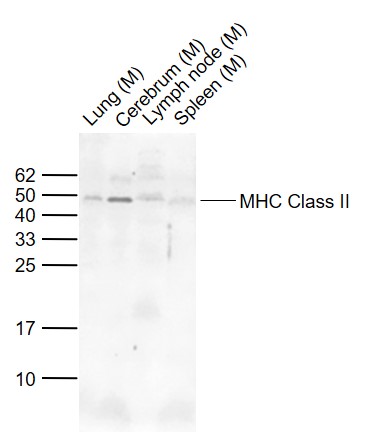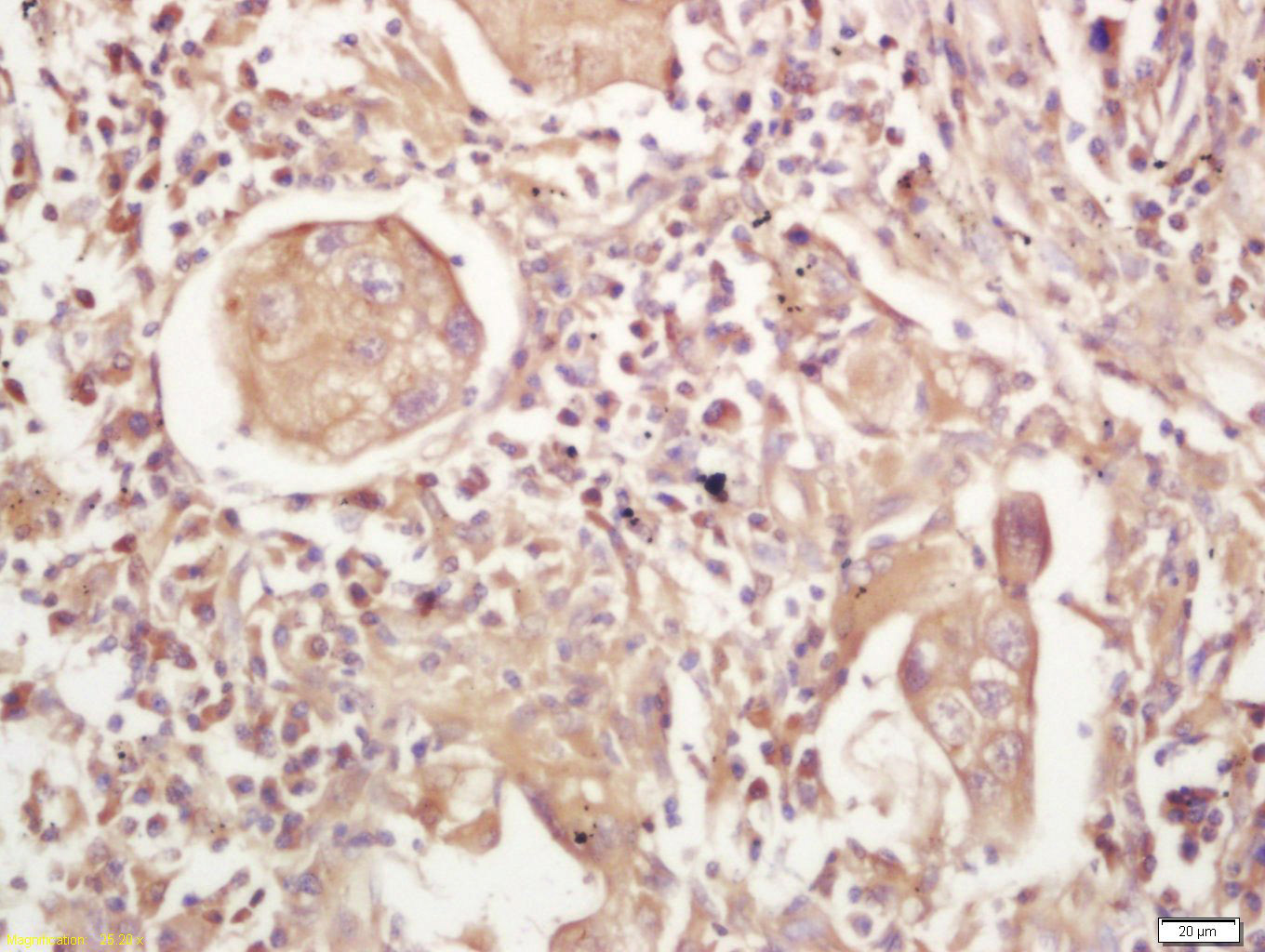
Rabbit Anti-MHC Class II antibody
HLA-DMB; HLA class II histocompatibility antigen, DM beta chain; HLA-DMβ; DMA; DMB; DP beta 1; DPB 1; DPB1; DRB; HLA class II histocompatibility antigen DM beta chain; HLA DMB; HLA DPB1; HLADM; HLADP1B; Major histocompatibility complex class II; Major his
View History [Clear]
Details
Product Name MHC Class II Chinese Name 组织相容性复合体蛋白2(HLA-DMB)抗体 Alias HLA-DMB; HLA class II histocompatibility antigen, DM beta chain; HLA-DMβ; DMA; DMB; DP beta 1; DPB 1; DPB1; DRB; HLA class II histocompatibility antigen DM beta chain; HLA DMB; HLA DPB1; HLADM; HLADP1B; Major histocompatibility complex class II; Major histocompatibility complex class II DP beta 1; MHC class II antigen DMB; MHC DPB1; RING6; RING7; MHC2; DMB_HUMAN. literatures Research Area Tumour Cell biology immunology Neurobiology Signal transduction Cell differentiation Immunogen Species Rabbit Clonality Polyclonal React Species Human, Mouse, (predicted: Rat, ) Applications WB=1:500-2000 ELISA=1:5000-10000 IHC-P=1:100-500 IHC-F=1:100-500 ICC=1:100-500 IF=1:100-500 (Paraffin sections need antigen repair)
not yet tested in other applications.
optimal dilutions/concentrations should be determined by the end user.Theoretical molecular weight 27kDa Cellular localization cytoplasmic The cell membrane Form Liquid Concentration 1mg/ml immunogen KLH conjugated synthetic peptide derived from human HLA class II histocompatibility antigen DM beta chain: 111-200/263 Lsotype IgG Purification affinity purified by Protein A Buffer Solution 0.01M TBS(pH7.4) with 1% BSA, 0.03% Proclin300 and 50% Glycerol. Storage Shipped at 4℃. Store at -20 °C for one year. Avoid repeated freeze/thaw cycles. Attention This product as supplied is intended for research use only, not for use in human, therapeutic or diagnostic applications. PubMed PubMed Product Detail MHC Class II antigens are heterodimers consisting of one alpha chain (31-34kD) and one beta chain (26-29kD). The family of monoclonal antibodies (ER-TR 3, ER-TR 2, ER-TR 1) detect MHC class II antigens encoded by the murine Ia region of the H-2 complex, corresponding to the human HLA-DR region. MHC Class II antigens are a valuable tool for studying T helper cell interaction with class II positive antigen presenting cells (dendritic cells, B cells, macrophages) and offer new possibilities for studying the development of T helper cells since these antibodies also stain stromal cells in the thymus. MHC Class II antigens are also inducible on a number of other cells (endothelium and epithelial cells) by interferon gamma.
Function:
Binds peptides derived from antigens that access the endocytic route of antigen presenting cells (APC) and presents them on the cell surface for recognition by the CD4 T-cells. The peptide binding cleft accomodates peptides of 10-30 residues. The peptides presented by MHC class II molecules are generated mostly by degradation of proteins that access the endocytic route, where they are processed by lysosomal proteases and other hydrolases. Exogenous antigens that have been endocytosed by the APC are thus readily available for presentation via MHC II molecules, and for this reason this antigen presentation pathway is usually referred to as exogenous. As membrane proteins on their way to degradation in lysosomes as part of their normal turn-over are also contained in the endosomal/lysosomal compartments, exogenous antigens must compete with those derived from endogenous components. Autophagy is also a source of endogenous peptides, autophagosomes constitutively fuse with MHC class II loading compartments. In addition to APCs, other cells of the gastrointestinal tract, such as epithelial cells, express MHC class II molecules and CD74 and act as APCs, which is an unusual trait of the GI tract. To produce a MHC class II molecule that presents an antigen, three MHC class II molecules (heterodimers of an alpha and a beta chain) associate with a CD74 trimer in the ER to form an heterononamer. Soon after the entry of this complex into the endosomal/lysosomal system where antigen processing occurs, CD74 undergoes a sequential degradation by various proteases, including CTSS and CTSL, leaving a small fragment termed CLIP (class-II-associated invariant chain peptide). The removal of CLIP is facilitated by HLA-DM via direct binding to the alpha-beta-CLIP complex so that CLIP is released. HLA-DM stabilizes MHC class II molecules until primary high affinity antigenic peptides are bound. The MHC II molecule bound to a peptide is then transported to the cell membrane surface. In B cells, the interaction between HLA-DM and MHC class II molecules is regulated by HLA-DO. Primary dendritic cells (DCs) also to express HLA-DO. Lysosomal miroenvironment has been implicated in the regulation of antigen loading into MHC II molecules, increased acidification produces increased proteolysis and efficient peptide loading.
Subunit:
Heterodimer of an alpha chain (DMA) and a beta chain (DMB).
Subcellular Location:
Cell membrane. Endoplasmic reticulum membrane. Golgi apparatus > trans-Golgi network membrane. Endosome membrane. Lysosome membrane. The MHC class II complex transits through a number of intracellular compartments in the endocytic pathway until it reaches the cell membrane for antigen presentation.
Similarity:
Belongs to the MHC class II family.
Contains 1 Ig-like C1-type (immunoglobulin-like) domain.
SWISS:
P28068
Gene ID:
3109
Database links:Entrez Gene: 3109 Human
SwissProt: P28068 Human
Product Picture
Primary: Anti-MHC Class II (SL8481R) at 1:200;
Secondary: HRP conjugated Goat Anti-Rabbit IgG(SL0295G-HRP) at 1: 3000;
ECL excitated the fluorescence;
Predicted band size : 27kD
Observed band size : 30kD
Sample:
Lane 1: Lung (Mouse) Lysate at 40 ug
Lane 2: Cerebrum (Mouse) Lysate at 40 ug
Lane 3: Lymph node (Mouse) Lysate at 40 ug
Lane 4: Spleen (Mouse) Lysate at 40 ug
Primary: Anti-MHC Class II (SL8481R) at 1/1000 dilution
Secondary: IRDye800CW Goat Anti-Rabbit IgG at 1/20000 dilution
Predicted band size: 29/50 kD
Observed band size: 50 kD
Tissue/cell: human lung carcinoma; 4% Paraformaldehyde-fixed and paraffin-embedded;
Antigen retrieval: citrate buffer ( 0.01M, pH 6.0 ), Boiling bathing for 15min; Block endogenous peroxidase by 3% Hydrogen peroxide for 30min; Blocking buffer (normal goat serum,C-0005) at 37℃ for 20 min;
Incubation: Anti-MHC Class II Polyclonal Antibody, Unconjugated(SL8481R) 1:200, overnight at 4°C, followed by conjugation to the secondary antibody(SP-0023) and DAB(C-0010) staining
References (0)
No References
Bought notes(bought amounts latest0)
No one bought this product
User Comment(Total0User Comment Num)
- No comment





 +86 571 56623320
+86 571 56623320
 +86 18668110335
+86 18668110335

